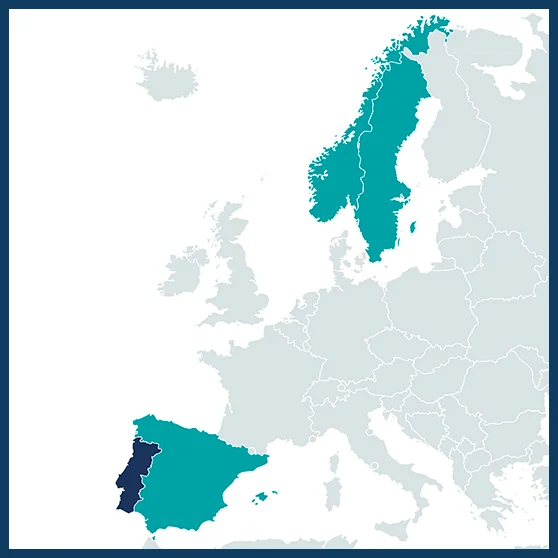01.04.2022 – 31.03.2025
€ 898,338
Cristina DELERUE-MATOS
cmm@isep.ipp.pt – han@isep.ipp.pt
Hendrikus NOUWS
han@isep.ipp.pt
Coordinator: Associated Laboratory for Green Chemistry (LAQV), Network of Chemistry and Technology (REQUIMTE), Porto, Portugal
Fluid Flow and Environmental Technology Department, Institute for Energy Technology, Kjeller, Norway
Research & Development Department, Águas do Centro Litoral, Coimbra, Portugal
Coastal & Marine Environmental Toxicology Department, Interdisciplinary Centre of Marine and Environmental Research (CIIMAR), Matosinhos, Portugal
Chemical Engineering Department, University of Vigo, Vigo, Spain
Physical & Analytical Chemistry Department, University of Oviedo, Oviedo, Spain
Biosystem & technology Department, Swedish University of Agricultural Sciences, Alnarp, Sweden

Pollution is threatening the biodiversity of inland waters that are vital to society and the future of the Earth. A major source of this pollution are effluent discharges from wastewater treatment plants. The treatment processes used in these plants do not efficiently remove emerging contaminants, such as pharmaceuticals and microplastics, which lead to health hazards to non-target species, including humans. This polluting source limits the conservation and restoration of freshwater systems. At the same time, there is a need for strategies to up-scale restoration solutions and for rapid and simple to use methodologies to assess conservation and restoration progress; i.e. assessment strategies anticipating the success of conservation/remediation measures in suitable timescales, ensuring reliable data comparison over time and space, and guiding intervention measures. BioReset will promote ecosystem recovery and conservation through a combined approach including: cutting-edge advances in existing wastewater treatment processes and developing methodologies to assess ecosystem conservation and restoration provided by these treatments based on investigating diatom communities, laying the foundation for a global quality index for ecological status and ecosystem assessment.
BioReset will thus advance treatment processes (chemical, physical, biological and their combination) to promote ecosystem recovery and conservation and to develop assessment strategies. Diatoms, unicellular algae that can be found all over the world in practically all kinds of aquatic environments, will be used to model ecosystem conservation and restoration since their communities show high levels of biodiversity. Application of Raman spectrosocopy to diatoms will provide an expeditious method to compare different recovery strategies and water treatment processes, allowing to address timescale and key conservation/restoration questions. The full environmental, economic, and social viability of the upgraded and innovative treatment technologies will be assessed. Based on this knowledge, scale-up studies in geographically different sites (Portugal and Spain) will be performed to ascertain the technical and economic feasibility at a larger scale and recommended action guidelines will be issued.
BioReset also envisages the creation of a representative space-time picture of the presence of emerging contaminants in inland waters and its correlation to effects on diatom communities. For this, powerful analytical techniques, such as gas- and liquid chromatography, will be used. Besides these methods, and to obtain real-time information, miniaturised analytical platforms that can perform fast and on-site monitoring will also be employed.
Knowledge transfer and validation within the scientific community, effective dissemination of practical outputs for incorporation by industry, and establishing credibility and attracting inputs from new stakeholders will be achieved through publications in international journals and presentations in conferences, an international workshop with multi-sector stakeholders at the end of the project, newsletters and press releases, and promotional material with technical information in digital format (BioReset’s website). This will lead to BioReset’s brand recognition, raising awareness on the topic and triggering policy changes according to the given recommendations.
The BioReset project will produce data about ecosystem recovery and conservation and methodologies for wastewater treatment and pollutant monitoring which is valuable information for policy makers, governmental authorities, wastewater treatment plant stakeholders, and environmental managers who design approaches and interventions to achieve and maintain biodiversity and a good ecological state of freshwater ecosystems. The project activities will be paired with outreach actions addressing regulatory authorities, industry, academia, and the general public to raise awareness and best practices towards ecosystems conservation. Because diatom communities will be used as bioindicators of ecosystems status, and wastewater treatment plants located in different countries are involved, BioReset will allow to draw implications and assessment strategies of global usefulness.
BioReset will contribute to halt degradation of freshwater ecosystems, promoting their conservation and creating the necessary conditions and strategies to regenerate their health and evaluate their recovery. The project is strongly aligned with the objectives of the European Green Deal and several Sustainable Development Goals (SDG) of the United Nations: SDG 6 – Clean water and sanitation, SDG 15 – Life on land, and SDG 17 – Partnerships for the goals. The participation of partners from different countries emphasises its real approach and aim of solving issues representing not a local but a worldwide problem. It is also aligned with 2030 targets of its post-2020 Global Biodiversity Framework, for example by deploying solutions to reduce threats to biodiversity, namely reducing chemical and plastic loads to the environment, by improving knowledge about the conservation and recovery of aquatic ecosystems and their monitoring, or by creating multi-stakeholder partnerships to generate solutions at the local, national, regional and global levels and mainstreaming biodiversity globally.
The best formulations for pharmaceutical and/or microplastic removal will be tested in pilot plants with wastewaters provided by Portuguese and Spanish wastewater treatment plants. These experiments will be carried out during the last semester of the third year of the Project. Diatom biofilms for ecosystem technologies and the electrochemical platforms will be tested to monitor the pharmaceutical and/or microplastic removal treatments.
- Agencia Estatal de Investigación (AEI), Spain
- The Research Council of Norway (RCN), Norway
- Fundação para a Ciência e a Tecnologia (FCT), Portugal
- Swedish Environmental Protection Agency (SEPA), Sweden